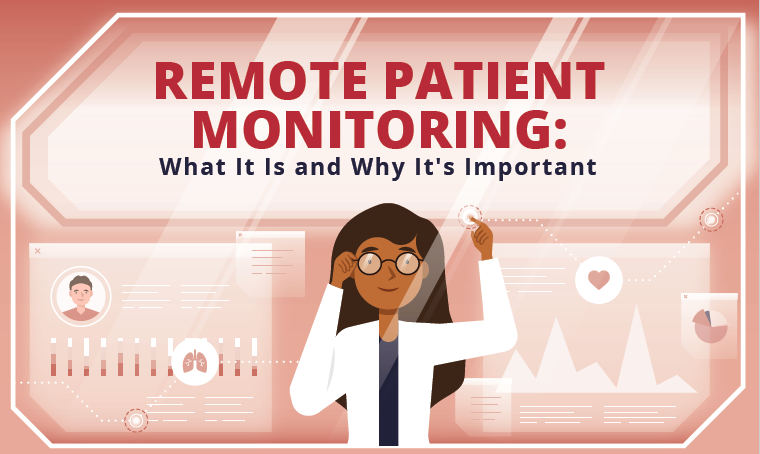Remote Patient Monitoring: What It Is and Why It’s Important

It has become increasingly popular to use apps, Bluetooth devices, and wearable monitors to connect patients to their doctors and help them stay on top of their health. According to Insider Intelligence, an estimated 30 million U.S. patients will use remote patient monitoring tools by 2024. With mobile devices in everyone’s hands, remote patient monitoring is convenient and effective, allowing people to be in control of their health.
To learn more, check out the infographic below, created by Maryville University’s online Master of Health Administration program.

What Is Remote Patient Monitoring?
Remote patient monitoring (RPM) allows healthcare providers to monitor and collect medical and health data using apps and wireless devices. It’s associated with a whole host of benefits. For example, RPM increases adherence, as 45% of people with chronic conditions consistently forget to take medications without help. It also minimizes the number of sudden emergencies that would happen to those people when they forget medication. Patients also like it, with one survey finding 37% felt they had more control over their personal health using RPM.
From Development to Widespread Adoption
Remote patient monitoring traces its roots back to 1948, when a doctor first sent X-ray images via telephone wires. Progress was slow, but by 1959, neurological exams were being electronically transmitted for consultation, and by the 1990s, use of the internet in healthcare settings had become commonplace — paving the way for easier RPM.
More recently, an Insider Intelligence survey showed that 23.4 million patients used RPM in 2020. The University of Pittsburgh employed the technology to reduce hospital readmissions by 76%. How did it become so successful? McKinsey attributes RPM’s adoption to patient willingness to use telehealth, incorporation by providers, and regulatory changes to access and reimbursement.
Remote Patient Monitoring Devices
Medical technology companies are driving innovation and growth in the field. Some of the most common RPM devices include blood pressure monitors, weight monitors, and glucose monitors. Blood pressure monitors allow practitioners to perform ongoing monitoring and treat hypertension, while continuous weight monitoring allows healthcare professionals to assess trends and measure their patients’ success. Glucose monitors can be critical, as they help mitigate risks that come from a sudden drop or rise in blood glucose level, alerting patients to take immediate action.
Leading RMP Companies
Dexcom develops, manufactures, and distributes continuous glucose monitoring systems for diabetes management. Medtronic’s remote respiratory monitoring system enables physicians to track a patient’s blood oxygen level, respiratory and pulse rate, and other vital signs. Philips Healthcare provides caregivers with tools to remotely track patients at home. ResMed uses cloud-connectable devices to track a sleeping patient’s health and respiration. Senseonics manufactures a long-term, implantable continuous glucose monitoring system for people with diabetes.
The Future of Remote Patient Monitoring
As more baby boomers choose to age safely in their homes and the healthcare industry looks to provide better care at lower cost, demand for remote patient monitoring will grow. In-home remote monitoring can provide patients, their families, and physicians with the confidence that a patient’s healthcare needs are being looked after.
So, what are the options for expanding RPM? Patients could receive tech-enabled medication administration, avoiding clinics and unnecessary in-person appointments. The shift to telehealth and RPM devices puts less stress on providers, allows for better patient-to-physician ratios, and frees more time for quality and focused care. With data being collected, healthcare providers can develop better population health insights and provide better care overall.
According to Insider Intelligence, the global RPM systems market will be worth more than $1.7 billion by 2027 — a 128% increase from its current valuation. Additionally, according to a 2021 Vivalink survey, 43% of medical providers believe that RPM will be on par with in-patient monitoring within five years.
RPM Will Continue to Grow
Technology continues to charge ahead, and the healthcare system is advancing along with it. Virtual visits, continuous monitoring, and tech-assisted services make getting care more convenient than ever. When healthcare providers have more data, they can better address their patients’ needs, and their patients can feel confident that their healthcare providers are caring for them. Remote patient monitoring is already being integrated into the healthcare system, and its use will continue to grow.
Sources
McKinsey & Company, “Telehealth: A Quarter-Trillion-Dollar Post-COVID-19 Reality?”
mHealthIntelligence, “Hospitals Are Finding ROI in Remote Patient Monitoring Programs”
MSI International Inc., “Americans View Remote Monitoring of Health Favorably”
Neoteryx, “A Brief History on the Remote Patient Monitoring System”
Prevounce, “A Comprehensive Guide to Remote Patient Monitoring”

